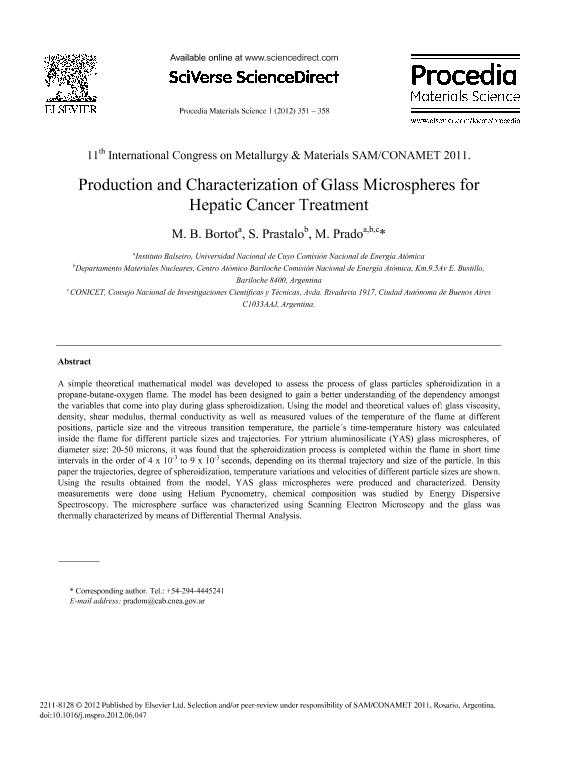Mostrar el registro sencillo del ítem
dc.contributor.author
Bortot, M. B.
dc.contributor.author
Prastalo, S.
dc.contributor.author
Prado, Miguel Oscar

dc.date.available
2017-01-10T19:15:49Z
dc.date.issued
2012-01
dc.identifier.citation
Bortot, M. B.; Prastalo, S.; Prado, Miguel Oscar; Production and Characterization of Glass Microspheres for Hepatic Cancer Treatment; Elsevier Science; Procedia Materials Science; 1; 1-2012; 351-358
dc.identifier.issn
2211-8128
dc.identifier.uri
http://hdl.handle.net/11336/11054
dc.description.abstract
A simple theoretical mathematical model was developed to assess the process of glass particles spheroidization in a propane-butane-oxygen flame. The model has been designed to gain a better understanding of the dependency amongst the variables that come into play during glass spheroidization. Using the model and theoretical values of: glass viscosity, density, shear modulus, thermal conductivity as well as measured values of the temperature of the flame at different positions, particle size and the vitreous transition temperature, the particle«s time-temperature history was calculated inside the flame for different particle sizes and trajectories. For yttrium aluminosilicate (YAS) glass microspheres, of diameter size: 20-50 microns, it was found that the spheroidization process is completed within the flame in short time intervals in the order of 4 x 10-3 to 9 x 10-3 seconds, depending on its thermal trajectory and size of the particle. In this paper the trajectories, degree of spheroidization, temperature variations and velocities of different particle sizes are shown. Using the results obtained from the model, YAS glass microspheres were produced and characterized. Density measurements were done using Helium Pycnometry, chemical composition was studied by Energy Dispersive Spectroscopy. The microsphere surface was characterized using Scanning Electron Microscopy and the glass was thermally characterized by means of Differential Thermal Analysis.
dc.format
application/pdf
dc.language.iso
eng
dc.publisher
Elsevier Science

dc.rights
info:eu-repo/semantics/openAccess
dc.rights.uri
https://creativecommons.org/licenses/by-nc-nd/2.5/ar/
dc.subject
Spheroidization
dc.subject
Yttrium Aluminosilicate Glass
dc.subject
Glass Microspheres
dc.subject.classification
Cerámicos

dc.subject.classification
Ingeniería de los Materiales

dc.subject.classification
INGENIERÍAS Y TECNOLOGÍAS

dc.subject.classification
Otras Ciencias de la Salud

dc.subject.classification
Ciencias de la Salud

dc.subject.classification
CIENCIAS MÉDICAS Y DE LA SALUD

dc.title
Production and Characterization of Glass Microspheres for Hepatic Cancer Treatment
dc.type
info:eu-repo/semantics/article
dc.type
info:ar-repo/semantics/artículo
dc.type
info:eu-repo/semantics/publishedVersion
dc.date.updated
2017-01-06T20:03:39Z
dc.journal.volume
1
dc.journal.pagination
351-358
dc.journal.pais
Países Bajos

dc.journal.ciudad
Ámsterdam
dc.description.fil
Fil: Bortot, M. B.. Comisión Nacional de Energía Atómica. Gerencia del Area de Energía Nuclear. Instituto Balseiro; Argentina. Universidad Nacional de Cuyo; Argentina
dc.description.fil
Fil: Prastalo, S.. Comision Nacional de Energia Atomica. Gerencia de Area de Aplicaciones de la Tecnologia Nuclear. Gerencia de Investigacion Aplicada. Grupo de Materiales Nucleares; Argentina
dc.description.fil
Fil: Prado, Miguel Oscar. Comision Nacional de Energia Atomica. Gerencia de Area de Aplicaciones de la Tecnologia Nuclear. Gerencia de Investigacion Aplicada. Grupo de Materiales Nucleares; Argentina. Comisión Nacional de Energía Atómica. Gerencia del Area de Energía Nuclear. Instituto Balseiro; Argentina. Universidad Nacional de Cuyo; Argentina. Consejo Nacional de Investigaciones Científicas y Técnicas; Argentina
dc.journal.title
Procedia Materials Science
dc.relation.alternativeid
info:eu-repo/semantics/altIdentifier/url/http://www.sciencedirect.com/science/article/pii/S221181281200048X
dc.relation.alternativeid
info:eu-repo/semantics/altIdentifier/doi/http://dx.doi.org/10.1016/j.mspro.2012.06.047
Archivos asociados
